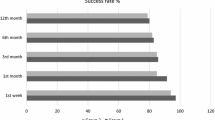Abstract
Objective
To assess the long-term results of intraoperative mitomycin C (MMC) in external dacryocystorhinostomy (EXT-DCR).
Methods
In this prospective randomized controlled study, 35 patients (40 eyes) with primary acquired nasolacrimal duct obstruction were assigned randomly into two groups. In the control group, a standard EXT-DCR procedure was performed. In the MMC group 0.2 mg/ml MMC was applied to the osteotomy site for 30 min. The results of EXT-DCR in both groups were evaluated by both asking patients about the tearing condition and examining the patency of irrigation at one-year follow up.
Results
Eighteen (90%) of the 20 eyes in the MMC group remained totally symptom-free and one eye (5%) improved; while 12 (60%) of 20 eyes in the control group were reported to be symptom-free and five (25%) of the eyes to have an improvement in the tearing symptoms (P = 0.087). The success rate in the MMC group was 95% compared with 85% in the control group (P = 0.605). No surgical complications occurred.
Conclusions
The satisfaction and success rates of the MMC group were higher than those of the control group and no deleterious effect was noted with MMC application, however the differences did not reach statistical significance. Intraoperative MMC application seems to be a safe adjuvant that could help in increasing the success rates of EXT-DCR surgery in primary acquired nasolacrimal duct obstruction ,however further studies with larger series are needed to make definite statements.
Similar content being viewed by others
References
Tarbet KJ, Custer PL (1995) External dacryocystorhinostomy: surgical success, patient satisfaction and economic cost. Ophthalmology 102:1065–1070
Zolli CL, Shannonn GM (1982) Dacryocystorhinostomy: a review of 119 cases. Ophthalmic Surg 13:905–910
Burns JA, Cahill KV (1985) Modified Kinosian dacryocystorhinostomy: a review of 122 cases. Ophthalmic Surg 16:710–716
Walland MJ, Rose GE (1994) Factors affecting the success rate of open lacrimal surgery. Br J Ophthalmol 78:888–891
McLachlan DL, Shannonn GM, Flanagan JC (1980) Results of dacryocystorhinostomy: analysis of the reoperations. Ophthalmic Surg 11:427–430
Allen K, Berlin AJ (1989) Dacryocystorhinostomy failure: association with nasolacrimal silicone intubation. Ophthalmic Surg 20:115–119
Bergstrom TJ, Wilkinson WS, Skuta GL, Watnick RL, Elner VM (1991) The effects of subconjunctival mitomycin C on glaucoma filtration surgery in rabbits. Arch Ophthalmol 109:1725–1730
Singh G, Wilson MR, Foster CS (1988) Mitomycin eye drops as treatment for pterygium. Ophthalmology 95:813–821
Megevand GS, Salmon JF, Scholtz RP, Murray AD (1995) The effect of reducing the exposure time of mitomycin C in glaucoma filtering surgery. Ophthalmology 102:84–90
Hu D, Sires BS, Tong DC, Royack GA, Oda D (2000) Effect of brief exposure to mitomycin C on cultured human nasal mucosa fibroblasts. Ophthal Plast Reconstr Surg 16:119–125
Yalaz M, Firinciogullari E, Zeren H (1999) Use of mitomycin C and 5-fluorouracil in external dacryocystorhinostomy. Orbit 18:239–245
Liao SL, Kao SCS, Tseng JHS, Chen MS, Hou PK (2000) Results of intraoperative mitomycin C application in dacryocystorhinostomy. Br J Ophthalmol 84:903–906
Kao SCS, Liao CL, Tseng JHS, Chen MS, Hou PK (1997) Dacryocystorhinostomy with intraoperative mitomycin C. Ophthalmology 104:86–91
Yeatts RP, Neves RB (1999) Use of mitomycin C in repeat dacryocystorhinostomy. Ophthal Plast Reconstr Surg 15:19–22
You YA, Fang CT (2001) Intraoperative mitomycin C in dacryocystorhinostomy. Ophthal Plast Reconstr Surg 17:115–119
Ugurbas SH, Zilelioglu G, Sargon MF, Anadolu Y, Akiner M, Aktürk T (1997) Histopathologic effects of mitomycin C on endoscopic transnasal dacryocystorhinostomy. Ophthalmic Surg Lasers 28:300–304
Dunn JP, Seamone CD, Ostler BH, Nickel BL, Beallo A (1991) Development of scleral ulceration and calcification after pterygium excision and mitomycin therapy. Am J Ophthalmol 112:343–345
Zacharria PT, Depperrman SR, Schuman JS (1993) Ocular hypotony after trabeculectomy with mitomycin C. Am J Ophthalmol 116:314–336
Author information
Authors and Affiliations
Corresponding author
Rights and permissions
About this article
Cite this article
Yildirim, C., Yaylali, V., Esme, A. et al. Long-term results of adjunctive use of mitomycin C in external dacryocystorhinostomy. Int Ophthalmol 27, 31–35 (2007). https://doi.org/10.1007/s10792-007-9057-6
Received:
Accepted:
Published:
Issue Date:
DOI: https://doi.org/10.1007/s10792-007-9057-6




